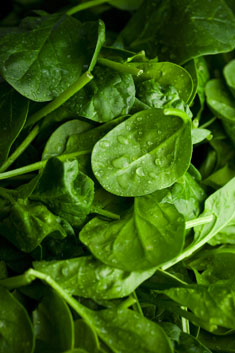Spinach Quest
Looking for lutein to keep her eyes healthy
By Helene Ragovin

The best sources of lutein are leafy greens—primarily spinach. Photo: iStockphoto
I’ll never look at a plate of spinach the same way again.
Spinach and other leafy greens are the main dietary source of lutein, a micronutrient that has been shown to help protect eyes against age-related macular degeneration (AMD), a sight-threatening disease that afflicts many older adults.
“By around age 70, one in six people have some degree of it, and by 80 years, one in three,” Elizabeth Johnson, a researcher at the Jean Mayer USDA Human Research Nutrition Center on Aging at Tufts (HNRCA), tells me. “Yikes,” I think, doing some quick arithmetic. Can I consume enough green vegetables over the next 20 to 30 years to remedy a lifetime of lutein neglect?
We head upstairs to the 11th floor of the HNRCA in downtown Boston, where the densitometer awaits. A black metal box with an eye cup protruding from the side, the densitometer is able to measure pigment in the macula, the part of the retina responsible for central vision.
The macular pigment is made up of lutein and its companion nutrient, zeaxanthin, both members of the carotenoid family. Of the hundreds of carotenoids in nature, and of about 30 in the body, only lutein and zeaxanthin are able to lodge directly in the macula. There, this yellow pigment absorbs light, protecting the macula from oxidative and light damage.
The process is painless. I look into the machine and watch a flickering, milky blue dot, turning knobs until the flickering ceases. I repeat the process several times over a 15-minute period. As I do this, the machine is calculating the amount of light being absorbed by my macular pigment, and thus how much lutein I have in my eye.
My level is “average.” But I resolve to do better. Can I, in the course of a month (the amount of time I have left to report this article), boost my pigment by eating more lutein-rich foods?
The best sources of lutein are leafy greens—primarily spinach, but also its cousins, chard, kale and beet greens. Lutein is also present in other green vegetables, and in egg yolks. (Goodbye Egg Beaters; hello omelets!) Johnson also informs me that the best way to absorb the lutein in greens is to eat them cooked, with a small amount of “good” fat. (“Not a glob!” she warns.) In other words, I don’t need to choke down spinach salads with non-fat dressing.
For the next four weeks, my diet takes on a Forrest Gumpian quality. I eat spinach pie, spinach bake, spinach squares, spinach quiche, spinach sauté, spinach soufflé. I branch out into chard (yummy with white beans), soups with escarole and lots of other green vegetables that contain lesser, but still decent, levels of lutein. I bring spinach and pasta to the office potluck.
I show Johnson a new frozen vegetable combination from Green Giant, called “Vision Health,” containing zucchini, green beans and carrots. “I don’t know if this vegetable selection is the best” for getting lutein, says Johnson, whom I am beginning to think of as the Lutein Queen. “But I’d rather someone eat this than supplements.” I even buy a bag of beet greens, but can’t quite figure out what to do with them.
Then it’s time for my re-test. On the elevator ride up to revisit the densitometer, Johnson reassures me that it takes some people months to increase their pigment levels, and I’ve only been at it for four weeks. But… yes! I’m up about 40 percent, Johnson says.
Anybody want a bag of beet greens?Helene Ragovin may be reached at helene.ragovin@tufts.edu.


